Fredrik Ljungström
| Fredrik Ljungström RNO KVO1kl | |
|---|---|
 Fredrik Ljungström (circa 1920) | |
| Born | 16 June 1875 |
| Died | 18 February 1964 (aged 88) |
| Nationality | Swedish |
| Education | Östra Real |
| Alma mater | Royal Institute of Technology |
| Occupation |
Engineer Technical designer Industrialist |
Fredrik Ljungström (16 June 1875 in Stockholm – 18 February 1964 in Stockholm), RNO KVO1kl, was a Swedish engineer, technical designer and industrialist, considered one of the foremost inventors from Sweden.[1][2]
Alone and in collaboration with his brother Birger Ljungström (1872–1948), he accounted for hundreds of innovative technical patents, from early bicycling techniques and mechanical automatic transmissions for vehicles, to historical steam turbines, innovative air preheaters and circular arc hulls for sailing boats. Apart from associations with industrialists such as Gustaf de Laval, Alfred Nobel, and John D. Rockefeller, Ljungström co-founded companies such as Ljungström Steam Turbine Co. and Swedish Turbine Manufacturing Co. As innovative as his ideas were in function, they also often turned out in terms of unconventional external design, such as his Ljungström steam turbine locomotives and Ljungström yachts.
At the time of World War II and its scarcity of resources, Fredrik Ljungström's innovative technology for oil shale underground gasification by electrical energy provided a significant strategical impact for the Royal Navy and Air Force.[3] In addition, Ljungström made important contributions to the first Swedish jet engine.
With Fredrik Ljungström's technology of the air preheater implemented in a vast amount of modern power stations around the world until this day, with total attributed worldwide fuel savings estimated to 4,500,000,000 tonnes (4,960,000,000 tons) of oil, "few inventions have been as successful in saving fuel as the Ljungström Air Preheater". In 1995, the Ljungström Air Preheater was distinguished as the 44th International Historic Mechanical Engineering Landmark by the American Society of Mechanical Engineers, rendering a permanent exhibition in the Swedish National Museum of Science and Technology in Stockholm.[4]

His works are also represented in other museums such as the Swedish Railway Museum, the Maritime Museum, the Nobel Museum, and the Lidingö Museum.
Early life and background
Born in Stockholm in 1875, Fredrik Ljungström was the son of Amalia Bernhardina and the inventor Jonas Patrik Ljungström, Junior, as well as the brother of Birger Ljungström inter alia. Fredrik Ljungtröm was educated at Östra Real, and attended the Royal Institute of Technology, where subsequently he was awarded an honorary Doctorate in 1944.
Svea Velocipede

The Svea Velocipede with locking hubs, an early invention by Fredrik and Birger Ljungström, now have units represented at the Swedish National Museum of Science and Technology and the Nordic Museum in Stockholm, Sweden.
Steam turbines
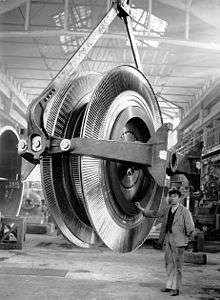

Fredrik and Birger Ljungström worked out a new type steam turbine, the Ljungström radial turbine, patented by his brother Birger Ljungström in 1894. The turbine principle was the base for the company ALÅ (Ljungström steam turbine Co.) founded in 1908 that owned all the patents. In 1913 they founded the separate company STAL (Swedish turbine manufacturing Co.), and moved the small workshop from Stockholm to Finspång. This company handled the manufacturing and sales of complete steam turbine driven electric generators. STAL was acquired in 1916 by ASEA as they wished to market complete packages with turbine driven electric generators. The brothers then left the company but kept control over the all the patents and manufacturing licenses for the Ljungström steam turbines within the company ALÅ.
Turbine locomotives



The brothers also designed a number of steam turbine locomotives, some of which were highly successful. The first attempt in 1921 was a rather odd-looking machine. Its three driving axles were located under the tender, and the cab and boiler sat on unpowered wheels. Later they changed this design with driving wheels on both the boiler carriage and the tender with separate turbines. The second design was a 2-8-0 similar to a successful freight design. Built in 1930 and 1936 by Nydqvist & Holm, these locomotives replaced conventional ones on the Grängesberg-Oxelösund Railway. No condenser was fitted, as its complexity outweighed its thermodynamic advantages. The wheels were driven by a jackshaft. These engines were not retired until the 1950s when the line was electrified.
Air preheater
Fredrik Lindström also invented an efficient air preheater, which even in a modern utility boiler provides up to 20 percent of the total heat transfer in the boiler process, but only represents 2 percent of the investment.[5]
Sailing boats
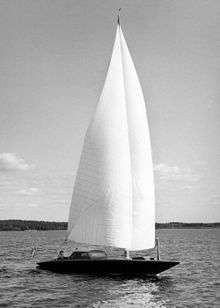
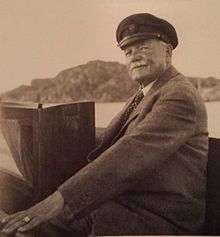
Fredrik Ljungström made several inventions out of new ideas related to sailing boats. The Ljungström sailboat with the circular arc hull and the Ljungström rig, without a boom and double sail that can work as a spinnaker, is named after Fredrik Ljungström.[6] The history of the productions are represented at the Maritime Museum in Stockholm.[7] He also experimented with a vibrationless yacht motor.
Other inventions
Fredrik Ljungström also invented a technology for oil shale underground gasification by electrical energy, the Ljungström method. In addition, Ljungström made important contributions to the first Swedish jet motor.
Image gallery
 STAL turbine generator (1932)
STAL turbine generator (1932) STAL turbine generator (1947)
STAL turbine generator (1947) Ljungström radial turbine.
Ljungström radial turbine.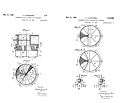 Main patent drawings for Ljungström heat exchanger, USPTO No. 1746598, 1930.
Main patent drawings for Ljungström heat exchanger, USPTO No. 1746598, 1930.
Distinctions
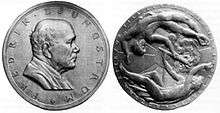
Orders
-
 Sweden: Knight of the Order of the Polar Star (1943)
Sweden: Knight of the Order of the Polar Star (1943) -
 Sweden: Knight 1st class of the Order of Vasa (1927)
Sweden: Knight 1st class of the Order of Vasa (1927) -
 France: Grand Cross of the National Order of Merit (1963)
France: Grand Cross of the National Order of Merit (1963)
Academic
-
 Honorary doctorate of the Royal Institute of Technology (1944)
Honorary doctorate of the Royal Institute of Technology (1944) -
 Honorary doctorate of the Dresden University of Technology (1928)
Honorary doctorate of the Dresden University of Technology (1928)
Awards
-
 KTH Great Prize of the Royal Institute of Technology (1948)[8]
KTH Great Prize of the Royal Institute of Technology (1948)[8] -
 James Watt International Gold Medal of the Institution of Mechanical Engineers (1949)[9]
James Watt International Gold Medal of the Institution of Mechanical Engineers (1949)[9] -
 International Historic Mechanical Engineering Landmark: Ljungström Air Preheater, by the American Society of Mechanical Engineers (1995)
International Historic Mechanical Engineering Landmark: Ljungström Air Preheater, by the American Society of Mechanical Engineers (1995) -
 Clason Medal of the Royal Swedish Academy of Engineering Sciences (1943)
Clason Medal of the Royal Swedish Academy of Engineering Sciences (1943) -
 Arnberg Prize from the Swedish Royal Academy of Sciences (1944)
Arnberg Prize from the Swedish Royal Academy of Sciences (1944) -
 Grashof Medal of the Association of German Engineers (1956)
Grashof Medal of the Association of German Engineers (1956) -
 Honorary Plaque of the Swedish Inventors' Association (1955)
Honorary Plaque of the Swedish Inventors' Association (1955) -
 Honorary Fellow of the Swedish Inventors' Association (1961)
Honorary Fellow of the Swedish Inventors' Association (1961) - Silver medal of the World Exposition for the Svea Velocopede
Fellowships
-
 Honorary Fellowship of the Royal Swedish Academy of Engineering Sciences (1940) (Fellowship since 1924)
Honorary Fellowship of the Royal Swedish Academy of Engineering Sciences (1940) (Fellowship since 1924) -
 Fellowship of the Royal Swedish Academy of Sciences (1945)
Fellowship of the Royal Swedish Academy of Sciences (1945)  Honorary Membership of the Institution of Mechanical Engineers (1950)[10]
Honorary Membership of the Institution of Mechanical Engineers (1950)[10]-
 Honorary Fellowship of the American Society of Mechanical Engineers (1950)
Honorary Fellowship of the American Society of Mechanical Engineers (1950)
Eponyms
-
 Ljungström Prize of the Swedish National Mechanics' Association (1971)
Ljungström Prize of the Swedish National Mechanics' Association (1971) -
 Rotor Medal of Svenska Rotor Maskiner (1957)
Rotor Medal of Svenska Rotor Maskiner (1957) -
 Birger and Fredrik Ljungström Commemorative Medal of the Royal Swedish Academy of Engineering Sciences (1976)
Birger and Fredrik Ljungström Commemorative Medal of the Royal Swedish Academy of Engineering Sciences (1976) -
 The International Ljungström (Air Preheater) Conference in Japan (1962)
The International Ljungström (Air Preheater) Conference in Japan (1962) -
 Permanent exhibition at the Swedish National Museum of Science and Technology (1995)
Permanent exhibition at the Swedish National Museum of Science and Technology (1995)
References
- ↑ http://www.tekniskamuseet.se/1/1889.html
- ↑ https://sites.google.com/site/ljungstromare/home
- ↑ https://sok.riksarkivet.se/sbl/Presentation.aspx?id=9630
- ↑ https://www.asme.org/getmedia/c7cf3d83-508f-4946-b476-9399c390fc83/185-Ljungstrom-Air-Preheater.aspx
- ↑ "The Ljungström Air Preheater 1920. An International Historic Mechanical Engineering Landmark" (PDF) (PDF). Svenska Mekanisters Riksförening; American Society of Mechanical Engineers. Retrieved 2009-01-10.
- ↑ https://sites.google.com/site/ljungstromare/links/yachting-1977
- ↑ http://digitaltmuseum.se/011024679896?page=5&query=fredrik%20ljungstr%C3%B6m&pos=113
- ↑ Samtliga pristagare kth.se, retrieved on 2009-02-05
- ↑ James Watt International Medal Recipients imeche.org, retrieved on 2009-02-05
- ↑ Svenska Dagbladet 19 March 1950, p. 3
Literature
- Fredrik Ljungström 1875-1964 Uppfinnare och inspiratör (1999) by Olle Ljungström, Sveriges Mekanisters Riksförening, ISBN 91-630-7639-X
External links
| Wikimedia Commons has media related to Fredrik Ljungström. |
- Biography at the Swedish National Museum of Science and Technology website
- STAL company page at the Swedish National Museum of Science and Technology website
- SRM 100 year jubilee, the story about the Ljungström brothers
- Free Patents Online: Fredrik Ljungstrom
- LJUNGSTRÖM Corporate website